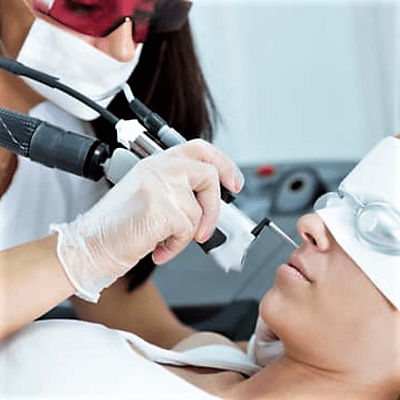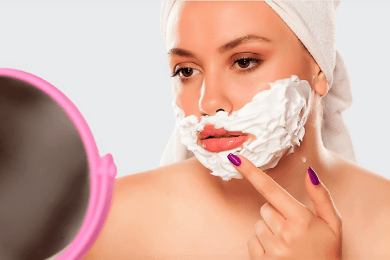Ultimate Guide to Laser Hair Removal
Laser hair removal is a modern miracle of cosmetology, offering the perfect solution to the eternal problem of unwanted hair.
unwanted hair.
This innovative method uses a beam of light with a specific wavelength to target and destroy hair follicles, slowing hair growth without damaging the surrounding skin.
Unlike traditional hair removal methods such as shaving, waxing and threading, which only provide a temporary solution, laser hair removal offers a more permanent approach to combating unwanted hair.
As technology advances, laser hair removal continues to evolve, becoming safer, faster and more affordable, cementing its status as a cornerstone in pursuing aesthetic excellence and convenience.
What is Laser Hair Removal?
Laser hair removal is a cosmetic procedure that uses a powerful laser or intense pulsed light to remove unwanted hair. During the process, a laser emits light absorbed by the pigment (melanin) in the hair. This light energy is converted to heat, which damages the tube-shaped sacs within the skin (hair follicles) that produce hairs. This damage inhibits or delays future hair growth.
When was laser technology first used for cosmetic procedures?
Theodore Maiman invented the first working laser in 1960. Initially, medical professionals explored lasers solely for medical applications such as surgery and dermatology rather than for cosmetic treatments.
Late 1960s–1970s: Researchers began experimenting with different lasers for skin conditions. For example, doctors used the argon laser to treat red birthmarks and other skin issues, an early step in making lasers useful for cosmetic purposes.
In 1983, Dr. R. Rox Anderson and Dr. John A. Parrish published the principle of “Selective Photothermolysis.” This revolutionary concept suggested that lasers could effectively treat various skin conditions by selectively targeting specific skin tissue without damaging surrounding tissue.
This principle has become the basis of many cosmetic laser procedures, including hair removal.
In the 1990s, Researchers and developers created and introduced the first lasers for hair removal.
In 1997, The US Food and Drug Administration (FDA) approved the first laser for hair removal. This milestone marks the official recognition of laser hair removal as a safe and effective method for eliminating unwanted hair.
How does the Laser Hair Removal Procedure Work?
During the laser hair removal procedure, the laser device emits a focused and intense beam of light at a specific wavelength, which melanin (a natural pigment) absorbs in the hair follicles. Melanin gives hair colour and plays a crucial role in the effectiveness of laser hair removal.
The light then converts into heat, targeting follicles rich in melanin without impacting the surrounding regions. Heat damages the structures inside hair follicles responsible for hair growth – the dermal papilla, located at the base of the hair follicle. The dermal papilla is essential for hair regeneration and development; it supplies the hair roots with nutrients, helping them grow.
As a result, hair growth slows or is delayed, leading to a noticeable decrease in hair density in the treated area.
Benefits of Laser Hair Removal
Precision: Laser technology precisely targets hair follicles, selectively heating them while leaving the surrounding skin undamaged.
Effectiveness: Laser hair removal can provide long-lasting results, reducing hair growth significantly after multiple sessions.
Speed: Each laser pulse can treat multiple hair follicles simultaneously, making the procedure quick, especially for smaller areas like the upper lip or underarms.
Painless: Laser hair removal is less painful than other hair removal methods, such as waxing or epilating. Some people may experience minimal discomfort.
Versatility: Laser hair removal can be performed on various body areas, including the face, legs, arms, bikini line, and back.
Convenience: Compared to other hair removal methods like shaving or waxing, laser hair removal offers longer-lasting results, reducing the need for frequent maintenance.
Prevention: One significant benefit of laser hair removal is its ability to prevent and reduce ingrown hairs.
Safety: When performed by a qualified technician, laser hair removal is generally safe, with minimal risk of side effects.
Smoothing: After the laser session, the skin is superficially exfoliated, removing dead skin cells from the outermost layer and leaving fresher, smoother skin underneath. This process also unclogs pores.
What is the Hair Growth Cycle?
The hair growth cycle has three phases: anagen, catagen, and telogen. Each phase is characterized by specific actions that affect the hair follicle.

Anagen (growth phase): This is the active growth phase of the hair follicles, during which the hair root cells rapidly divide, increasing the volume of the hair shaft. Body hair, including hair on the arms, legs, chest and back, typically grows at about 0.1 to 0.2 centimetres (cm) per month, depending on genetics, age, health and other factors.
Catagen (Transitional Phase): The catagen phase is a short, transitional stage that lasts about 10 days. In this phase, the hair follicle shrinks and detaches from the dermal papilla, ending the growth phase. The hair is now referred to as club-shaped and lacks melanin.
Telogen (resting phase): The resting phase lasts about 3 months, during which the hair does not grow but remains attached to the follicle. Approximately 10-15% of all hair is in this phase. At the end of the telogen phase, the hair follicle enters the anagen phase again, and new hair begins to grow, displacing the old hair.
What is melanin?
Melanin is a natural pigment in hair and skin that gives it colour. Lasers used for hair removal emit specific wavelengths of light, predominantly absorbed by the melanin in the hair shaft. The darker the hair, the more melanin it contains and the more efficiently it absorbs laser light.
Successful hair removal with laser technology depends on several key parameters that influence the effectiveness of the procedure and the outcomes. Understanding these factors can help tailor the treatment to individual needs, optimizing results. Here are the critical parameters:
Skin Type and Colour; Hair Colour; Laser Type and Wavelength; Technician’s Expertise and Overall Health and Hormonal Background.
How do different skin types and colours respond to laser hair removal?
Different skin types respond differently to laser hair removal due to variations in melanin levels.
Lighter skin with darker hair typically responds best to laser hair removal because the contrast between the skin and hair allows the laser to target the hair follicles more effectively. However, darker skin tones contain more melanin and thus may sustain damage from the laser.
Scientific research has led to developing different lasers capable of working on dark skin tones without risking damage. Alexandrite and Diode lasers are commonly used for hair removal on lighter skin, whereas Diode and Nd: Yag Lasers are suitable for darker skin tones.
The Fitzpatrick Phototype scale is commonly used as a guide to determine skin type.

The Fitzpatrick scale categorizes human skin into six different types, labelled from I to VI, based on how it responds to sun exposure and its tendency to burn or tan. Here’s a breakdown:
- Type I (Light/Pale): Individuals with fair or pale skin, often accompanied by light blonde or red hair and light-coloured eyes. Ethnic groups commonly associated with this are Northern European and Scandinavian.
- Type II (Fair/Light): People with fair skin may have some freckling. They usually have light to medium blonde or brown hair and light-coloured eyes. Ethnic groups commonly associated with them are Caucasian, Northern European, and Mediterranean.
- Type III (Medium/Fair): Individuals with a moderate complexion, often with light to medium brown hair and eyes. Ethnic groups commonly associated: Caucasian, Mediterranean, Middle Eastern, Hispanic/Latino.
- Type IV (Medium/Olive): People with an olive or light brown complexion, typically dark brown or black hair and brown eyes. Ethnic groups commonly associated: Mediterranean, Middle Eastern, Hispanic/Latino, and South Asian.
- Type V (Dark/Brown): Those with a darker brown complexion, often with dark brown to black hair and brown eyes. Ethnic groups commonly associated: African, African American, Afro-Caribbean, and South Asian.
- Type VI (Very Dark/Black): Individuals with dark brown to black complexion, commonly with black hair and dark brown eyes. Ethnic groups widely associated: Sub-Saharan African, African American, and Afro-Caribbean.
Understanding the Fitzpatrick skin type can assist practitioners in selecting the appropriate laser type for laser hair removal treatment, thereby reducing the risk of skin damage.
What are the most effective skin types and hair colours for Laser Hair Removal?
Overall individuals with lighter skin tones (Fitzpatrick skin types I-III) and darker, coarser hair typically experience the most effective and efficient results with laser hair removal treatments.
However, advancements in laser technology have made it possible to achieve satisfactory results for a broader range of skin types and hair colours. It’s essential to consult with a qualified and experienced laser technician to determine the most suitable treatment plan based on individual characteristics.
Who is laser hair removal treatment for?
Indeed, laser hair removal is generally recommended for individuals aged 18 and older without contraindications.
It can be beneficial for people of various backgrounds, including those with polycystic ovary syndrome (PCOS), transgender individuals, men, and women experiencing excessive hair growth.
However, consulting with a healthcare professional or qualified practitioner is essential to ensure laser epilation suits your specific circumstances and to discuss any potential risks or considerations.
How many treatments will I need?
Typical Number of Sessions: 6 to 8 Sessions. Most people require between 6 to 8 sessions to achieve significant hair reduction. This range accounts for the majority of hair types and body areas.
Factors Influencing the Number of Treatments:
- Hair Growth Cycle: Hair grows in cycles, and laser hair removal is only effective on hair that is in the active growth phase. Not all hairs are in this phase simultaneously, so multiple sessions are necessary to catch different hairs as they enter this phase.
- Hair Colour and Type: Darker and coarser hair typically responds better to laser treatment, requiring fewer sessions. Lighter or finer hair may require more sessions for effective results.
- Skin Type: The laser settings can vary for different skin types to ensure safety and effectiveness, which can also influence the number of sessions needed.
- Area of the Body: Different body areas have different hair growth rates and densities. For example, the lower leg area and underarms usually respond faster to laser treatment than the back or Bikini.
What is the interval between treatments?

Spacing Between Sessions
Sessions are typically spaced 4 weeks apart for facial hair and 6 to 8 weeks apart for body hair. This spacing allows the treatment to target hairs that enter the growth phase (anagen) subsequently, as the laser is most effective during this phase.
Which areas are more popular for women to remove hair?
Commonly, women seek laser hair removal in areas where unwanted hair is a frequent concern:
- Face: upper Lip& Chin, Half Face, full face
- Legs
- Underarms
- Bikini Area
- Arms
Which areas are more popular for men to remove hair?
- Back & Shoulders
- Chest
- Abdomen
- Cheekbones
- Neck & Beard Area
- Upper Arm
- Buttocks
- Bikini Area
What should I do before treatment, and how I prepare for it?
Preparing for laser hair removal involves several essential steps to ensure the treatment is safe and effective. Here’s what you should do before your appointment:
Stop Plucking and Waxing: Avoid waxing, plucking, and electrolysis for 4 to 6 weeks before treatment. These methods remove the hair root, which is needed as a target for the laser during the treatment.
Shave the Treatment Area: Shave the treatment area 24 to 48 hours before the session. Shaving removes hair from the surface, leaving the roots intact. This helps the laser effectively target the follicles.
Clean the Skin: On the day of your appointment, ensure the treatment area is clean and free of cosmetics, lotions, and sunscreen.
Review Medications: Some medications, such as certain antibiotics, can increase photosensitivity. Discuss any medications you take with your technician to avoid complications during treatment.
Wear Comfortable Clothing: Wear clothing that will allow easy access to the treated area and is comfortable after the procedure.
By following these steps, you’ll help maximize the effectiveness of your treatment and minimize any potential side effects.
What should I avoid before treatment?
Here’s what you should generally avoid before your laser treatment:
- Sun Exposure: Avoid sunbathing, using tanning beds, and sun exposure for at least 4 to 6 weeks before treatment. Sun-tanned skin can lead to pigment changes and other complications during laser treatment.
- Avoid Photosensitizing Medications and Blood-Thinning Medications.
- Skin Irritation or Damage: Avoid chemical peels or other skin treatments that can irritate the skin for at least 2 weeks before your laser session.
- Beauty and Skincare Products:
- Stop using products containing retinol or alpha hydroxy acids at least 2 weeks before treatment, as these can increase skin sensitivity.
- Perfumes and Deodorants: On the day of the treatment, avoid using perfumes, deodorants, or any potentially irritating products on the area to be treated.
- Vigorous exercise
- Alcohol

Patch Test
How It’s Conducted:
A patch test is an important step before a laser hair removal session. The test helps determine how your skin responds to the laser and ensures treatment settings are appropriate for your skin and hair type. This is a general overview of what to expect and what’s important.
- Consultation.
The practitioner will discuss medical history, skin type, previous skin treatments, and medications you are taking to assess factors that may affect treatment.
- Patch Test
A small area on the skin, usually hidden or unseen, will be selected for the test.
- Applying the Laser
The laser technician will apply the laser to a small skin area, using several settings to see which is best for your skin type.
- Observation
The skin reaction is monitored immediately after application and over the next few days. This monitoring helps to determine if any delayed reactions occur.
How long does a laser session take?
The duration of a laser hair removal session can vary significantly depending on the size of the area being treated and the laser machine used. Here’s a general guideline for various body parts:
Small Areas: Upper Lip or Chin: Typically takes about 2 to 5 minutes. Underarms: Each underarm can take about 5 to 10 minutes.
Medium Areas: Bikini Line: This can take about 15 minutes. Full Face: Usually takes about 20 minutes.
Large Areas: Legs: Each leg can take about 30 minutes, depending on whether it’s the lower or full legs. Back: It can take about 30 – 40 minutes, depending on hair density and the size of the area.
Very Large Areas: Whole Body: A session can take up to 2 hours.
What should I do after laser hair removal treatment?
We recommend following Prima Britannia Laser Clinic Laser Hair Removal Aftercare recommendation for the best outcome without complications.
Which types of lasers are suitable for laser hair removal?
Here’s a brief overview of the most commonly used lasers:
- Alexandrite Laser:
Wavelength: 755 nm
Suitable for: Light to olive skin tones
Features: It is fast and effective, has a good track record for treating larger body areas, and is one of the most widely used lasers for hair removal. - Diode Laser:
Wavelength: 810 nm
Suitable for: Light to medium skin tones
Features: It is particularly effective on darker hair and can be used on various skin types. It provides deeper penetration and can be more effective on coarser hair. - Nd: YAG Laser:
Wavelength: 1064 nm
Suitable for darker skin tones
Features: Its less melanin absorption makes it safer for darker skin. Therefore, it’s effective for treating ingrown hairs and less likely to cause hyperpigmentation. - Intense Pulsed Light (IPL):
Not a laser: Uses broad-spectrum visible light
Suitable for: Light skin with dark hair
Features: It is more versatile than laser treatments and can be adjusted to different wavelengths. However, it is less specific and may require more sessions than lasers.
Prima Britannia Laser Clinic utilises a gold-standard laser system, Cynosure Elite+, which includes Alexandrite and Nd: Yag lasers.
Are there any side effects from laser hair removal?
Laser hair removal can have some side effects, though they are usually minor and temporary. Here are the most common ones:
- Skin Irritation: Temporary discomfort, redness, and swelling are common immediately after the procedure. These symptoms typically subside within several hours to a few days.
- Pigment Changes: The treated area may show some changes in skin colour. It can lighten or darken, especially if you don’t follow pre-treatment and post-treatment care instructions regarding sun exposure. This is more pronounced in people with darker skin tones.
- Blistering and Burns: Although rare when performed correctly, burns and blisters can occur if the laser settings are too high or the skin is recently tanned.
- Scarring: Very rare and typically associated with improper technique or post-treatment care, scarring can occur.
- Hair Changes: Some people may experience changes to the texture or colour of their hair if it regrows.
- Rare Side Effects: More unusual risks include activating herpes simplex virus (if prone to cold sores) and bacterial infections.
To minimize the risk of side effects, it’s important to choose a qualified and experienced practitioner and follow all pre-treatment and post-treatment instructions.
Laser Hair Removal in Hammersmith and Chiswick
Did you find the information useful, or do you have more questions? Prima Britannia Laser Clinic has served the Hammersmith area for over 12 years. Our experienced practitioners, all specially qualified in laser procedures, are here to help you achieve your desired results.
For additional details or to schedule your free consultation, please reach out to us:
- Contact our clinic directly at 02087417420
- Use the contact form on our website: www.primabritannia.co.uk
Don’t forget to follow us on Instagram for the latest updates and insights!
We look forward to assisting you on your smooth, hair-free skin journey!





